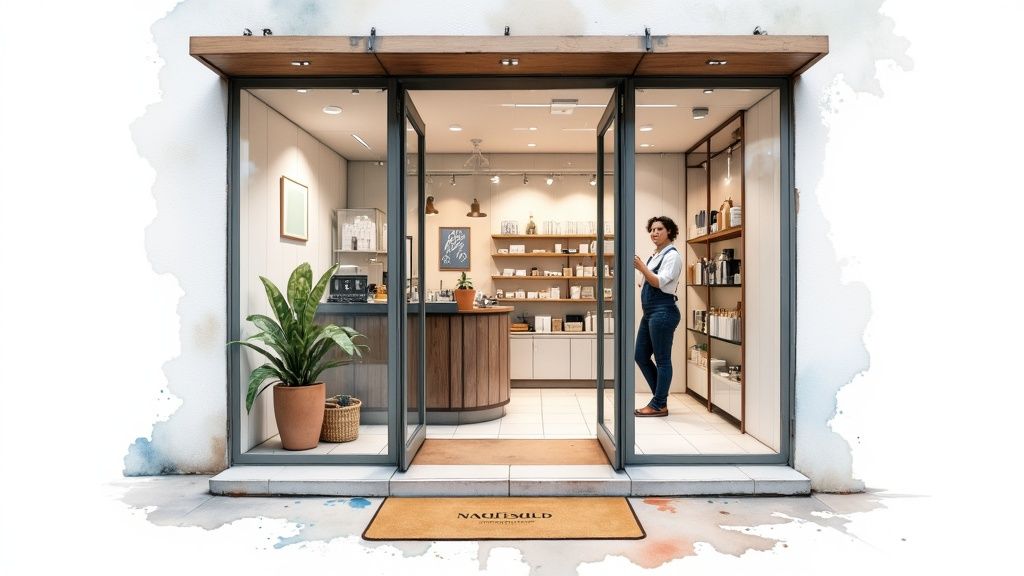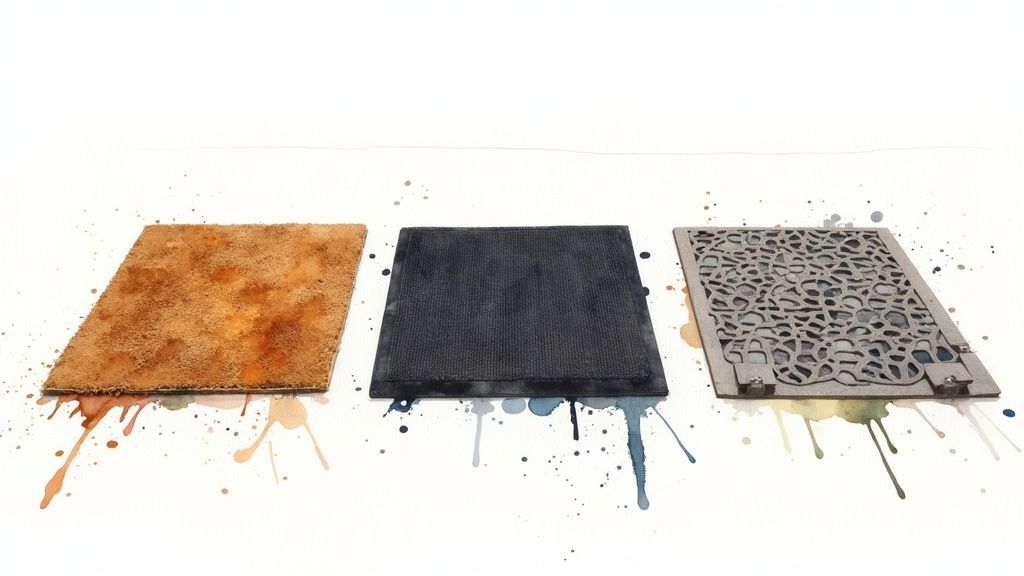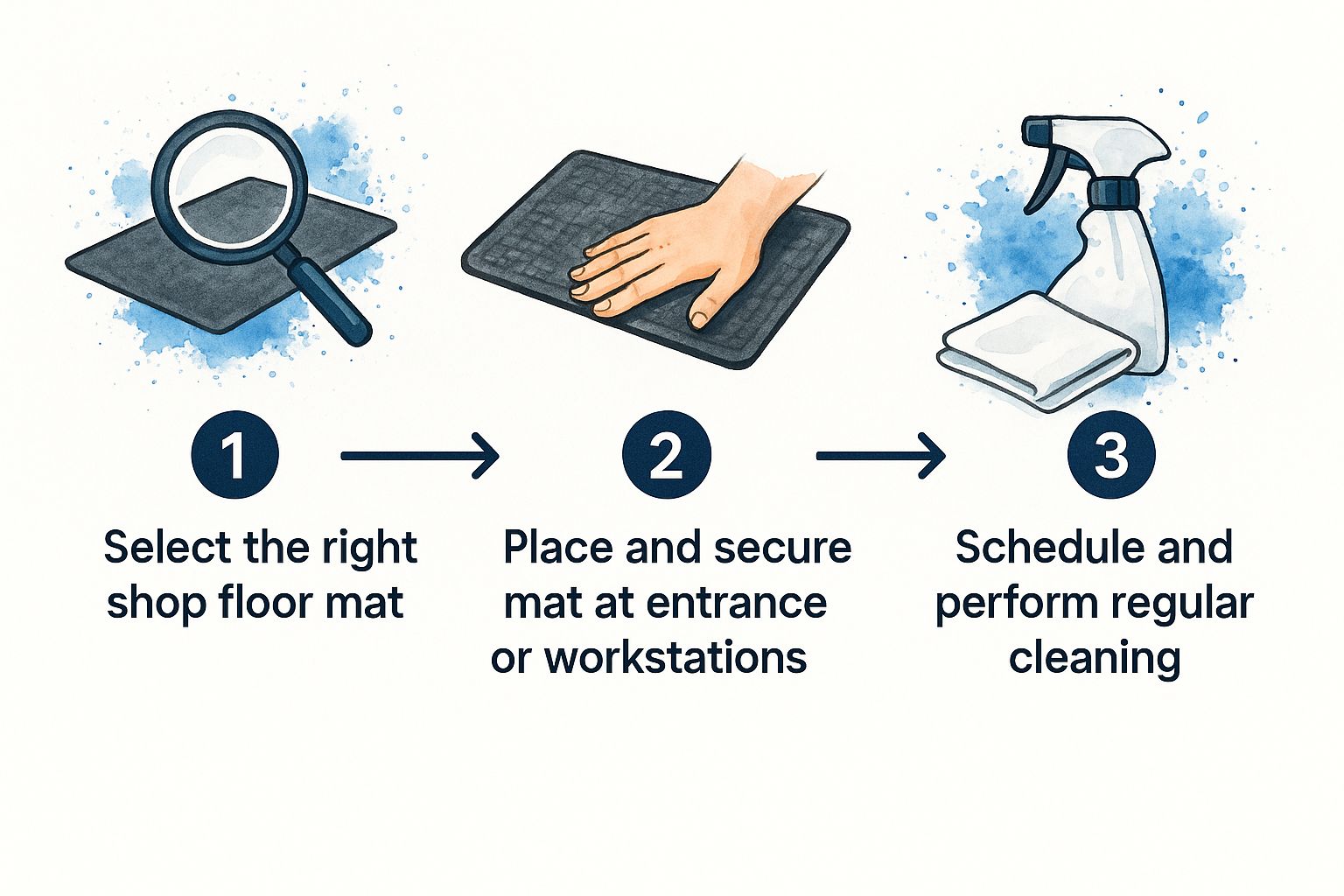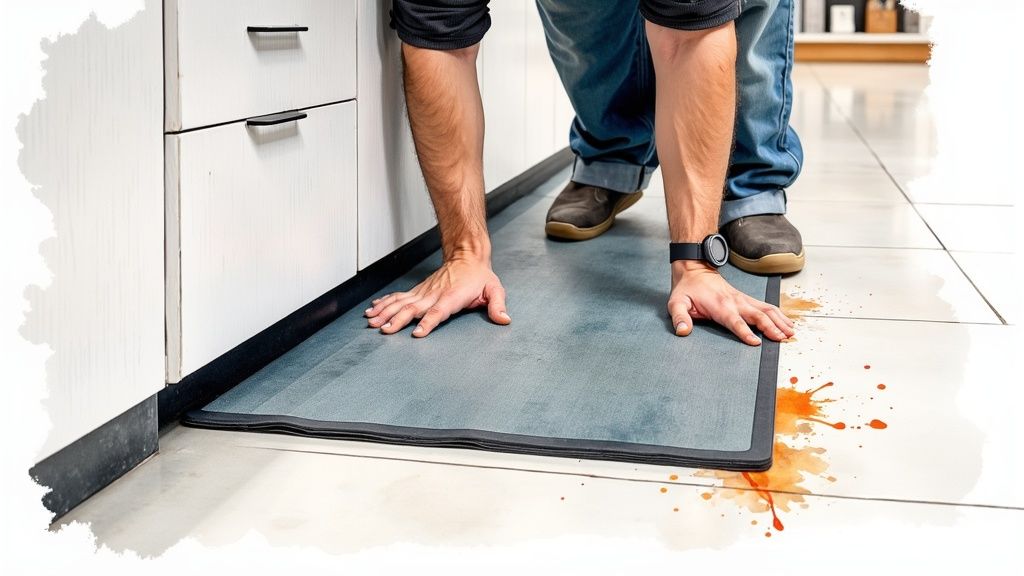Choosing the right floor mats for shops isn’t just about keeping the place clean. It’s a practical investment that directly impacts your business's safety, efficiency, and brand image. A well-planned matting system is a foundational step that protects your customers, your team, and your property from day one.
How the Right Floor Mat Delivers Tangible Benefits

Think of your floor mats as the unsung heroes of your shop. They perform critical jobs you only notice when something goes wrong, like a sudden slip-and-fall incident or a permanent stain on your flooring.
Investing in quality matting isn't an operational expense; it's a strategic move to boost safety, slash cleaning costs, and improve the experience for every person who walks through your door. It’s no surprise the global floor mats market, valued at around USD 9.8 billion, is expected to hit USD 15.2 billion by 2032. As market analysis on sites like Dataintelo.com shows, this growth is fueled by an intense focus on workplace hygiene and safety.
The Three Core Jobs of an Effective Shop Mat
To choose the best mat, you must first define its job. An effective matting system always performs three key functions, delivering clear benefits.
-
Stopping Dirt and Moisture at the Door: An entrance mat is your first line of defense. Its primary job is to scrape off debris and absorb water before it gets tracked across your floors. Benefit: This immediately reduces the risk of slippery surfaces and cuts down on cleaning labor and costs.
-
Preventing Slips in High-Risk Zones: Areas like break rooms, floral departments, or drink stations are prone to spills. The right mat provides critical traction in these zones. Benefit: This turns a potential hazard into a safe walkway, significantly reducing the likelihood of costly slip-and-fall accidents.
-
Easing Fatigue for Standing Staff: Team members on their feet all day at cash registers, service counters, or assembly stations need support. Anti-fatigue mats are essential here. Benefit: The cushioning reduces physical strain, which improves employee comfort, focus, and productivity while decreasing absenteeism.
Real-World Example: A busy downtown café was constantly battling slick floors on rainy days, requiring nonstop mopping. After a customer nearly fell, they implemented a two-part mat system: a tough scraper mat outside and a large, absorbent wiper mat inside. The actionable takeaway: This system captured over 80% of incoming moisture and dirt. The immediate benefit was a drastic reduction in cleaning time and a visibly safer, more professional entrance.
Quick Guide to Shop Mat Selection
Here’s a practical table to help you match your shop's primary need with the right type of mat and its direct benefit.
| Primary Need | Recommended Mat Type | How It Solves Your Problem |
|---|---|---|
| Stop Outside Dirt & Water | Scraper Mat / Wiper Mat Combo | Traps grit and moisture at the door, keeping floors clean and preventing slips. |
| Improve Employee Comfort | Anti-Fatigue Mat | Reduces back and leg strain for staff, which can boost morale and reduce fatigue-related errors. |
| Enhance Brand Image | Logo Mat | Makes a professional first impression and reinforces your brand identity to every visitor. |
| Prevent Slips from Spills | Absorbent or Drainage Mat | Provides immediate traction and contains liquids in spill-prone areas like kitchens or workshops. |
How to Assess Your Shop’s Needs: An Actionable Checklist
Before buying, walk through your space and analyze your specific challenges. A one-size-fits-all approach doesn't work. Ask these key questions to make a smart investment:
- What is my main entrance like? Is it exposed to rain and snow, or is it inside a clean mall? An exposed entrance needs a heavy-duty outdoor scraper mat followed by an indoor wiper mat. A mall entrance might only need a high-quality wiper mat.
- Where do my employees stand for long periods? Identify every workstation, checkout counter, and packing station. These are the exact spots where you need to place anti-fatigue mats.
- Which areas are prone to spills? Note any drink stations, wash-up sinks, or industrial areas where liquids are used. These zones require absorbent or drainage mats to maintain safety.
Matching Mat Materials to Real-World Shop Needs

The performance of any floor mat comes down to its material. Choosing correctly is the difference between a mat that just lies there and one that actively protects your floors, staff, and customers. This practical decision directly impacts daily safety and cleanliness.
Let's break down the common materials and how they solve specific problems, so you can get the performance you’re paying for.
Scraper Mats: Your First Line of Defense
Think of a scraper mat as the tough gatekeeper at your entrance. Placed outside, its single job is to aggressively remove heavy debris like mud, snow, and large particles before they enter your shop. These mats are typically made from durable 100% rubber or feature a coarse, bristly surface designed for harsh weather and high foot traffic.
Real-World Example: A garden center faces customers tracking in soil, mulch, and wet leaves. How they solve it: A heavy-duty rubber scraper mat outside the entrance acts like a giant boot brush, dislodging the worst of the mess. The benefit: This single mat prevents a huge amount of debris from entering, dramatically reducing sweeping and mopping time.
Wiper Mats for Moisture and Fine Dust
Once inside, the mission shifts from scraping to absorbing. This is where carpet-topped mats (wiper mats) take over. Their purpose is to soak up water and trap the fine dust and grit that scraper mats miss. These mats have a fabric top, usually polypropylene, fused to a non-slip rubber or vinyl back. For best results, choose a bi-level surface design that scrapes shoes while lower channels trap water, keeping the walking surface drier.
Actionable Insight: A quality wiper mat is a non-negotiable tool for preventing slip-and-fall accidents. By capturing moisture at the entrance, you protect your main flooring and create a much safer environment for everyone.
Specialty Materials for Unique Challenges
Some areas have unique hazards like grease, chemicals, or all-day standing workstations. These spots need mats specifically engineered for those problems.
- Nitrile Rubber Mats: This is the go-to material for areas exposed to oil, grease, or chemicals. Standard rubber degrades in these conditions, but nitrile is highly resistant. How to use it: Place them in auto repair shops, commercial kitchens, and industrial workstations to prevent mat deterioration and maintain a safe, non-slip surface.
- Anti-Fatigue Mats: When employees stand for hours, comfort becomes a safety issue. These mats use cushioned foam or rubber to provide support and encourage micro-movements that improve circulation. If you're curious, you can learn more about how anti-fatigue mats work in our detailed guide. How to use it: Place them at checkout counters, packing stations, and service desks. The benefit: This small investment yields significant returns in employee well-being and productivity.
Strategic Mat Placement for Maximum Safety
You can have the best floor mats, but if they're the wrong size or poorly placed, they are ineffective and can even become a trip hazard. A mat that is too small or constantly shifts is a liability.
Proper placement isn't a final detail—it's a core part of your safety strategy. The goal is to create a seamless, safe transition from outside to inside by placing mats where they will be most effective.
The 10-15 Foot Rule for Entrances
A key principle for effective matting is the “10-15 foot rule.” It takes several steps for shoe soles to shed the dirt and water they carry. This rule ensures you provide enough matting to capture it all.
This means you need at least 10 to 15 feet of continuous mat coverage inside your entrance. This allows for at least two steps with each foot, which is typically enough to remove the vast majority of grime and moisture. A single 3'x5' mat at a busy door is insufficient; on a rainy day, people will track water right past it, creating dangerous slippery conditions.
Real-World Example: Supermarkets almost always use long runner mats that stretch well into the store. This is the 10-15 foot rule in action. The strategy: By the time a customer and their cart reach the polished aisle, their shoes and the cart wheels are significantly cleaner and drier. The benefit: This simple placement drastically reduces slip-and-fall risks throughout the store.
This visual shows how selection, placement, and maintenance work together.

As you can see, choosing the right mat is just step one. Where you put it and how you care for it are what truly deliver the long-term safety and cleanliness you're after.
Custom Cuts vs. Standard Sizes
When outfitting your shop, you'll choose between standard mats and custom-cut solutions. Standard sizes are convenient and cost-effective but often leave unsafe gaps in complex layouts. For awkward corners, L-shaped hallways, or large areas, a custom-cut mat is a smarter investment. It provides wall-to-wall coverage, eliminating gaps where water can pool and preventing the curled edges that create trip hazards. If you want to dive deeper, check out our guide on the essentials of floor safety mats.
Here are actionable tips for perfect placement:
- Walkways: The mat must cover the entire width of the walkway. If it's too narrow, people will step on and off the edge, creating a trip risk.
- Workstations: Ensure anti-fatigue mats are large enough for employees to move comfortably without constantly stepping on and off the mat's edges.
- Wet Areas: For a produce aisle or drink fountain area, use a long, wide runner mat to contain expected spills, drips, and overspray effectively.
Turning Floor Mats into a Branding Tool

Your floor mats are more than a utility; they are prime marketing real estate. Every person who enters your shop looks down, making your entrance mat the first and last physical touchpoint with your business.
Turning this space into a branding opportunity is a smart way to make a lasting impression. A custom logo mat transforms a practical item into a powerful marketing asset. It immediately communicates professionalism and reinforces your brand identity before a customer even speaks to an employee.
How to Choose the Right Style for Your Brand
The type of logo mat you choose should align with your brand’s personality and the mat's location. You have two excellent options for bringing your logo to life on floor mats for shops:
-
Printed Carpet Mats: These are ideal for displaying intricate, colorful, and detailed logos. Using advanced printing technology, we can replicate your branding with photographic quality. How to use them: Perfect for indoor locations like high-end retail shops, salons, or corporate offices where you want a vibrant, polished welcome.
-
Inlaid Rubber Mats: For entrances exposed to weather or areas with extreme wear, inlaid mats are the best choice. Different colored pieces of durable rubber are cut and fitted together like a puzzle to form your logo. The design is incredibly tough and won't fade. How to use them: Ideal for settings that demand rugged durability, like hardware stores or high-traffic commercial buildings.
Real-World Example: A local hardware store wanted to reinforce its tough, reliable image. Their solution: They chose a heavy-duty inlaid rubber logo mat for their main entrance. The benefit: It withstood muddy work boots and constant traffic while instantly communicating the store's core value of durability to every customer.
Actionable Design Tips for Logo Mats
An effective logo mat must be both attractive and functional. Retailers increasingly want mats to match their specific branding, driving growth in the USD 8.6 billion carpet floor mats market.
To get the best results, follow these design tips:
- Choose High-Contrast Colours: A logo that pops gets noticed. Ensure your logo's colors stand out against the mat's background.
- Design for Dirt: Darker backgrounds or mottled, flecked patterns are brilliant at hiding dirt, keeping your entrance looking sharp between cleanings.
- Keep It Simple: A clean, uncluttered design often has a greater impact. A strong logo and a short tagline are all you need.
A well-designed logo mat does two jobs at once: it keeps your shop safe and clean while actively greeting every visitor with your unique brand identity.
A Practical Cleaning Plan for Your Shop Mats
A quality floor mat is an investment in your shop's safety and image, but it needs protection. A dirty, waterlogged mat stops working and can become a source of odors or a safety hazard. Protecting your investment is simple with a consistent maintenance plan, ensuring your mats last for years.
How to Build Your Mat Maintenance Schedule
The right cleaning approach depends on the mat type and its foot traffic. A heavy-duty rubber scraper mat needs a different routine than a carpeted logo mat in a quiet area.
Here’s a practical, step-by-step checklist to adapt for your shop:
-
Daily Action (For High-Traffic Mats):
- Carpeted Mats: Vacuum thoroughly to remove surface dirt and debris. This prevents grit from grinding into the fibers and causing premature wear.
- Rubber Mats: Shake them out or give them a quick sweep. If muddy, hose them down for a fast, effective clean.
-
Weekly Action (For All Mats):
- Spot Cleaning: Immediately tackle spills on carpeted mats with a mild detergent and a clean cloth to prevent stains from setting.
- Full Inspection: Check all mats for wear and tear, especially curled edges, rips, or cracks. A damaged mat is a trip hazard and must be replaced.
-
Monthly (Or As-Needed) Deep Cleaning:
- Deep Extraction: Use a carpet extractor or pressure washer (on a low setting) on carpet-topped mats to remove deeply embedded grime.
- Scrub-Down: For solid rubber or nitrile mats, especially in workshops, scrub with a deck brush and a gentle cleaning solution to remove built-up grease.
Actionable Takeaway: The most critical step is ensuring the mat is 100% dry before placing it back down. A damp mat can grow mold and mildew underneath, and its edges may curl, creating a dangerous trip hazard.
Common Cleaning Mistakes to Avoid
Proper cleaning extends a mat's life, but wrong methods can destroy it. Avoid using harsh chemicals like bleach or ammonia-based cleaners on rubber, as they cause it to become brittle and crack. Likewise, being too aggressive with a pressure washer can separate the carpet top from its backing. Always start with the gentlest method first.
For more straightforward advice, check out these 5 tips on how to keep your entrance mat clean. This can save you from a costly replacement mistake.
Your Top Questions About Shop Floor Mats, Answered
Even with a plan, practical questions arise. Getting clear answers helps you maximize the safety, cleanliness, and value of your matting.
Here are the most common questions from shop managers.
How Often Should I Actually Replace My Mats?
There is no fixed "use by" date. A mat's lifespan depends on its quality, material, and foot traffic. A high-quality nitrile rubber mat in a busy storefront might last 3-5 years, while a cheap vinyl mat in the same spot could fail in less than a year. The key is regular inspection.
Here is an actionable checklist for when to replace a mat:
- Check for Curled or Cracked Edges: This is a primary trip hazard. Replace immediately.
- Assess the Pile: If a carpeted mat's surface feels hard and flat, its fibers are crushed and no longer effective at scraping or absorbing.
- Look for Visible Backing: If the rubber or vinyl backing shows through the top, the mat is structurally compromised and must be replaced.
Can I Just Use an Outdoor Mat Inside?
You can, but it's an ineffective strategy. Outdoor mats are designed to be aggressive scrapers for heavy debris like mud and slush; they do not absorb water well. Using one indoors means moisture and fine dust will be tracked past it, making your interior floors slippery.
Actionable Strategy: Implement a two-mat system. Place a tough scraper mat outside the entrance, followed immediately by a high-quality, absorbent wiper mat inside. This system captures both coarse debris and fine moisture for maximum floor protection.
Are Anti-Fatigue Mats Really Worth the Money?
Yes, the return on investment is clear. Standing on hard surfaces causes significant physical pain in the feet, legs, and back, leading to distraction, lower productivity, and increased sick days.
Real-world scenario: A mechanic on a concrete garage floor or a barista working an eight-hour shift will experience fatigue. The solution: An anti-fatigue mat provides cushioning that encourages small muscle movements, improving blood flow and dramatically reducing physical strain. The small cost of a quality mat is easily offset by the long-term benefits of a healthier, more focused team.
How Do I Stop My Mats from Sliding Around?
A moving mat is a serious liability. The solution depends on your floor type.
- For hard floors (tile, concrete, LVT): Use a mat with a high-traction nitrile rubber backing, which grips much better than vinyl.
- For carpeted floors: Look for a cleated or gripper-style backing. These nubs dig into the carpet pile to anchor the mat.
Actionable Tip: Always ensure the floor underneath is clean and dry before placing the mat. If a mat continues to move in a high-traffic area, investing in a heavier, higher-quality mat is often the best solution, as its weight will provide a natural anchor.
Ready to put these solutions into action? Mats4U offers expert advice and a huge range of high-performance entrance, anti-fatigue, and custom logo mats designed for any commercial space. Check out our collection and find the perfect mat for your shop.







